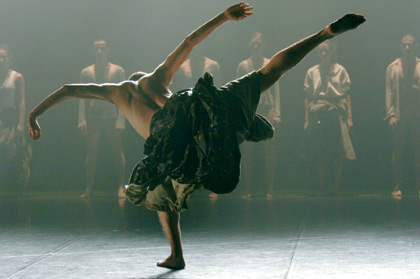In the communal and religious life of the Jewish
people, dance has been regarded as an expression of joy and sorrow since
biblical times and is today an integral part of religious, national,
community, and family celebrations. Contemporary dance has developed in
two directions: expansion of the folk dance genre which accompanied the
early settlers in the rebuilding of their ancient homeland; and the
establishment of art dance, leading to stage productions created by
professional choreographers and performed by trained dancers.
Dance as an art form was introduced in the country in the 1920s by
newly arrived teachers and devotees of dance from the cultural centers
of Europe. After the establishment of the state, it was developed to a
high professional level by a number of ensembles, each founded on the
basis of a different orientation and style. Today more than a dozen
major professional dance companies, most of them based in Tel Aviv,
perform a varied repertoire throughout the country and abroad.
The Israel Ballet
grew out of a studio for classical dance set up by its artistic
directors, Berta Yampolsky and Hillel Markman. The only professional
classical ballet company in the country, it performs classical,
neo-classical and contemporary works created by Yampolsky as well as
ballets by Balanchine and other international choreographers.
The Kibbutz Contemporary Dance Company
was founded in 1970 by Yehudit Arnon, member of Kibbutz Ga'aton in the
Galilee, near the Lebanese border. Arnon turned a group of young amateur
dancers into one of Israel's leading contemporary dance companies,
steadily gaining international acclaim. Today, the KCDC is identified
with its artistic director and choreographer Rami Beer.

Photo courtesy of the Kibbutz Contemporary Dance Company
Founded in 1964 by Martha Graham and the Baroness Batsheva De Rothschild, the Batsheva Dance Company
was initially based on Graham's methods, but always placed a strong
emphasis on ballet training. Over forty years on, the company is perhaps
the best known global ambassador of Israeli culture and it employs 65
members, from dancers to technical crew members. Currently, Ohad Naharin
is the artistic director, and Sharon Eyal the house choreographer.
Like many dance companies in Israel, Batsheva has an educational
agenda and has a number of outreach programs which aim to bring dance to
all sectors of Israeli society. According to the company, Batsheva's
works are expressive, dynamic, innovative, emotive, and esthetic, all of
which reflect the energy of the country.
Vertigo
is a highly successful modern dance group founded in 1992 by two
dancers, Noa Wertheim and Adi Sha'al. Touring worldwide, it has already
received several international awards for its work. Much of its
repertoire features original choreography by Wertheim, as well as
innovative dance projects with other artists. The Vertigo Dance School
in Jerusalem, founded in 1997, provides amateur and professional tuition
in classical ballet, modern dance and improvisation.
Inbal Pinto Dance Company's
choreographer and designer Inbal Pinto is one of the rising stars of
international dance. A former member of the Batsheva Dance Company, she
has received numerous dance awards since she began choreographing in
1990. Together with Co-Artistic Director Avshalom Pollack, Pinto has
created numerous dance pieces, such as the world famous work, Oyster,
which has been performed hundreds of times in Israel and abroad.
The country's modern dance scene is further enhanced by a number of
smaller groups and independent choreographers whose work has been highly
appreciated by dance lovers all over the world. The most prominent of
these is Yasmeen Godder, who won the Bessie Award in 2001 in New York
and numerous awards in Israel. Her dance language is based around the
female form, and her work, Two Playful Pink, has been performed
worldwide. Other rising stars include Emanuel Gat and Renana Raz